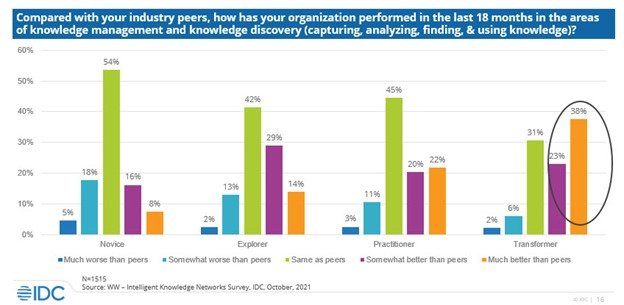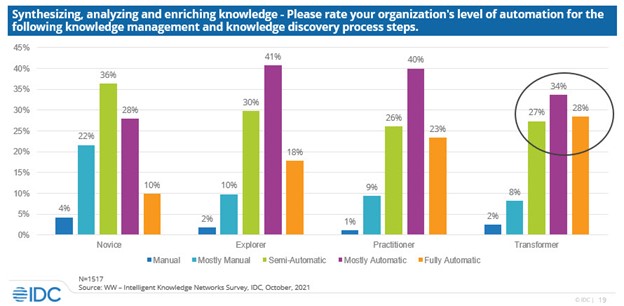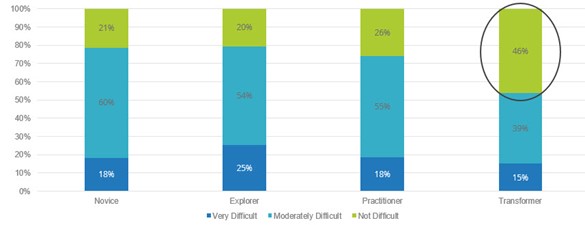
Knowledge management “transformers” enjoy (and acknowledge) their success
It’s not necessarily boasting to acknowledge one’s accomplishments. We all have strengths and weaknesses, and it’s important to recognize both – to improve as needed, and to leverage our assets to best effect.
According to IDC’s recent Intelligent Knowledge Networks (IKN) survey*, a significant majority (over 60%) of the most sophisticated users of knowledge management systems – organizations IDC categorizes as “Transformers” – recognize and appreciate their advantages. Over six in ten say they are somewhat or much better than their industry peers in knowledge management and knowledge discovery.

These enterprises, according to IDC, “holistically collect and capture information from a large number of sources across the enterprise, use advanced tools and technologies to synthesize and share that knowledge and exhibit a company culture that promotes knowledge sharing… resulting in increases in productivity and better returns on investment.”
One attribute that gives “transformers” their knowledge management advantage is their use of automation to synthesize, analyze and enrich knowledge. Well over a quarter (28%) of such companies say they are fully automated in this function. That means at these organizations, for a typical market or competitive intelligence project, the system is now doing work that used to consume hours of end users’ time – time spent searching through research and news reports, culling search results, reading selected findings, and distilling down key insights – at a productivity cost that can reasonably be estimated at thousands of dollars per person per project. In other words, for a large enterprise with thousands of professionals in decision-making roles, millions of dollars are at stake annually.

A key underlying technology enabling the automation-driven productivity IDC’s study reports is AI-based machine learning. In a research portal application, for example, AI can enable the computer to read research reports and articles and tell a user what it finds. AI is how a knowledge management system can fulfill the stated goal of an insights and analytics manager at a technology manufacturer, who told IDC: “We didn’t want people to search; we want to provide answers to them directly at their fingertips before they even do a search.”
Significantly, advanced knowledge management functionality deployed at sophisticated organizations does not necessarily equate to complexity for users. Nearly half (46%) of the “transformers” IDC surveyed say their knowledge management systems are not difficult to use for automated information synthesis. That’s a full 20 points better than the second tier of knowledge management user organizations – IDC calls them “Practitioners” – reported. Whether that difference is due to transformers having deployed better systems, greater comfort using them, or both, it points to the direction knowledge management must go to be even more widely embraced.

We suspect as more organizations come up the knowledge management sophistication curve, a higher percentage will report using automated features and will find them more usable across a wide range of use cases, including but not limited to market and competitive intelligence. And many will be happy to acknowledge their success.
* IDC multi-client study, “Intelligent Knowledge Networks Survey Analysis”, document number US48814422, December 2021
